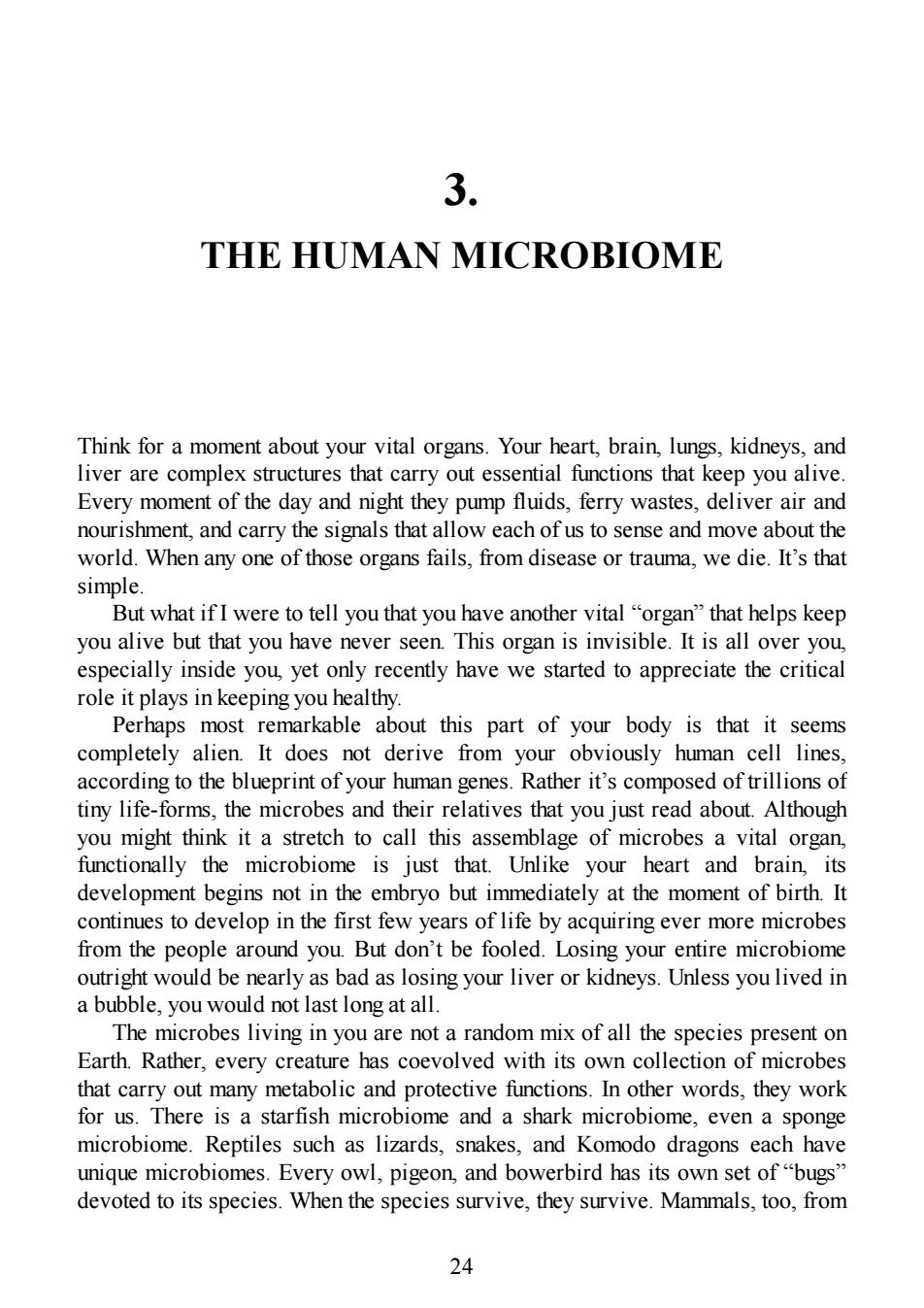正在加载图片...

3. THE HUMAN MICROBIOME Think for a moment about your vital organs.Your heart,brain,lungs,kidneys,and liver are complex structures that carry out essential functions that keep you alive. Every moment of the day and night they pump fluids,ferry wastes,deliver air and nourishment,and carry the signals that allow each of us to sense and move about the world.When any one of those organs fails,from disease or trauma,we die.It's that simple. But what if I were to tell you that you have another vital "organ"that helps keep you alive but that you have never seen.This organ is invisible.It is all over you, especially inside you,yet only recently have we started to appreciate the critical role it plays in keeping you healthy. Perhaps most remarkable about this part of your body is that it seems completely alien.It does not derive from your obviously human cell lines, according to the blueprint of your human genes.Rather it's composed of trillions of tiny life-forms,the microbes and their relatives that you just read about.Although you might think it a stretch to call this assemblage of microbes a vital organ, functionally the microbiome is just that.Unlike your heart and brain,its development begins not in the embryo but immediately at the moment of birth.It continues to develop in the first few years of life by acquiring ever more microbes from the people around you.But don't be fooled.Losing your entire microbiome outright would be nearly as bad as losing your liver or kidneys.Unless you lived in a bubble,you would not last long at all. The microbes living in you are not a random mix of all the species present on Earth.Rather,every creature has coevolved with its own collection of microbes that carry out many metabolic and protective functions.In other words,they work for us.There is a starfish microbiome and a shark microbiome,even a sponge microbiome.Reptiles such as lizards,snakes,and Komodo dragons each have unique microbiomes.Every owl,pigeon,and bowerbird has its own set of"bugs" devoted to its species.When the species survive,they survive.Mammals,too,from 33. THE HUMAN MICROBIOME Think for a moment about your vital organs. Your heart, brain, lungs, kidneys, and liver are complex structures that carry out essential functions that keep you alive. Every moment of the day and night they pump fluids, ferry wastes, deliver air and nourishment, and carry the signals that allow each of us to sense and move about the world. When any one of those organs fails, from disease or trauma, we die. It’s that simple. But what if I were to tell you that you have another vital “organ” that helps keep you alive but that you have never seen. This organ is invisible. It is all over you, especially inside you, yet only recently have we started to appreciate the critical role it plays in keeping you healthy. Perhaps most remarkable about this part of your body is that it seems completely alien. It does not derive from your obviously human cell lines, according to the blueprint of your human genes. Rather it’s composed of trillions of tiny life-forms, the microbes and their relatives that you just read about. Although you might think it a stretch to call this assemblage of microbes a vital organ, functionally the microbiome is just that. Unlike your heart and brain, its development begins not in the embryo but immediately at the moment of birth. It continues to develop in the first few years of life by acquiring ever more microbes from the people around you. But don’t be fooled. Losing your entire microbiome outright would be nearly as bad as losing your liver or kidneys. Unless you lived in a bubble, you would not last long at all. The microbes living in you are not a random mix of all the species present on Earth. Rather, every creature has coevolved with its own collection of microbes that carry out many metabolic and protective functions. In other words, they work for us. There is a starfish microbiome and a shark microbiome, even a sponge microbiome. Reptiles such as lizards, snakes, and Komodo dragons each have unique microbiomes. Every owl, pigeon, and bowerbird has its own set of “bugs” devoted to its species. When the species survive, they survive. Mammals, too, from 24